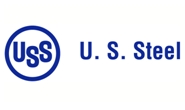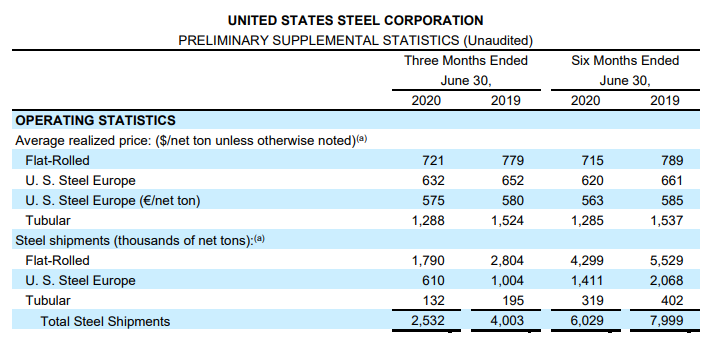Steel Mills

U.S. Steel Q2 Loss Highlights Need for “Best of Both” Strategy
Written by Sandy Williams
August 1, 2020
“Second-quarter results are a reminder of why we have to change,” said U.S. Steel President and CEO David Burritt, during his quarterly conference. The second quarter marked the trough of a challenging year, he said, as U.S. Steel remains focused on its “best of both” strategy, which includes the acquisition of EAF mill Big River Steel as well as completion of the Fairfield EAF and other projects that will allow the company to become more flexible, efficient and profitable when the market hits the bottom.
U.S. Steel’s net sales fell to $2.09 billion during the quarter as operating losses were recorded in each of its operating segments due to pandemic-related shutdowns and diminishing demand. Shipments totaled 1.8 million tons with an average selling price of $721 per ton. The company posted a net loss of $589 million, but still exceeded its second-quarter guidance.
A commitment to increasing cash and liquidity added $1.4 billion to the balance sheet through sale of secured notes and common stock. Total liquidity as of June 30 was $2.7 billion. Building up cash reserves will help mitigate any new challenges that may occur during or following the COVID-19 pandemic as well as keeping U.S. Steel on track to purchase the remaining 50.1 percent stake in Big River Steel sometime within the next three years. Burritt said. U.S. Steel will “pull the trigger” on the acquisition at the appropriate time, he added. In the meantime the company will look to increase liquidity by actively marketing noncore assets and real estate options.
Big River Steel is currently profitable and operating at almost full capacity. Its Phase 2A expansion is ahead of schedule and on budget. When completed, capacity at BRS will be doubled while adding 100 employees.
Demand is improving in end markets, especially in automotive since the restart of operations in June. Although the ramp-up was slower than expected, it has quickly accelerated and restocking of inventory, especially SUVs and pickup trucks, has benefited U.S. Steel order books, the company said.
Construction was resilient during the quarter and is expected to remain so in the third quarter. Appliance rebounded in the second quarter following a brief pause at the onset of the pandemic and is expected to continue to strengthen in Q3. Third-quarter order books are exceeding expectations, said Burritt.
U.S. Steel Granite City, which services the energy and packaging markets, was able to stay operable utilizing one blast furnace during the quarter due to robust orders for steel used for food and essential supply packaging.
Energy and tubular remain challenging with tubular nearing market bottom. Fairfield’s consolidated operations can satisfy demand for most of U.S. Steel’s market share. Tubular results are expected to be flat to slightly better in Q3.
Flat rolled shipments increased by 50 percent in the second half of June compared to the first half, said CFO Christie Breves. “We believe the second half of June was the tipping point for our order book as shipments accelerated and have continued to improve into the third quarter.”
“The rebound is currently underway in these four key indices, automotive, appliance, construction and packaging,” said Burritt. “Our new order intake in the month of June and July are 174 percent of the levels in April and May. Furthermore, 59 percent of new orders on our mills in the month of July are tied to demand signals from our customers in September and October. In other words, we have line of sight to these end user volumes continuing at least into the fourth quarter.”
Regarding the July 21 price increase, Burritt said it is too early to tell if it is sticking, but the company is seeing some early success based on recent order status.
Two Furnaces to Remain Idled This Year
Two of U.S. Steel’s blast furnaces (Gary #4 and Granite City A) will remain idled for the remainder of the year. Gary BF #8 will return to production on Aug. 1. The Keetac iron ore mine is indefinitely idled and coking times have been extended at Clairton.
U.S. Steel executives emphasized that blast furnaces will be turned back on when order books indicate demand from customers. “I would think for now, due to the order book we have in hand and the continuing strength we’re seeing, we’re comfortable with the three blast furnace configuration at Gary, one at Granite City and two at Mon Valley within the flat roll segment,” said Kevin Lewis, VP, Investor Relations.
“I think the key point here is the customer will decide where we take this business,” added Burritt. “The stronger the customer need, the more we’re going to be responding to them, and that means we’ll be turning things on. If things go badly, then we have to turn them off, but it’s customer-focused always.”
The EAF at Fairfield Tubular is on track for completion in the fourth quarter of 2020. The endless casting and rolling expansion at Mon Valley and the hot strip mill at Gary have been delayed for an indeterminate time. The Dynamo line at USSK has also been delayed.
Commenting on the outlook, Burritt said, “The second quarter is the low. The third quarter book looks good. We expect things to improve, but we don’t expect this quick recovery in the third quarter. It will be a bit episodic following probably the COVID-19 pandemic. Once we have a vaccine in place, we feel really good about pivoting quickly to the future. We think it’s incredibly bright longer term as we see an infrastructure build.
“We see the election being over, a lot of the divisiveness going away, and we think there’s a lot of money that’s sitting on the sidelines wanting to go to work. It’s largely dependent on the success of how the world deals with the pandemic. But longer term I’d say, with our best of both strategy, we’re cautiously bullish about the longer term and feel really good about finding our way through the short term into the future.”

Sandy Williams
Read more from Sandy WilliamsLatest in Steel Mills

Algoma fires up EAF steelmaking with first arc
Algoma Steel reached a milestone in its transformation from blast furnace to electric arc furnace (EAF) steelmaking, with its Unit One EAF achieving its first steel production this week.

Nucor holds HR list price at $910/ton
Nucor is keeping its list price for spot hot-rolled coil unchanged after last week’s shortened holiday week.

Cliffs unveils new hydrogen-powered stainless line in Ohio
CEO Lourenco Goncalves, flanked by state leaders and union reps, touted the project as proof that US manufacturing is not only alive, but also advancing.

Cliffs idles Steelton, Riverdale, and Conshohocken operations
Cliffs has idled facilities in Riverdale, Ill., and Conshohocken and Steelton, Pa.

Radius loss narrows, volumes climb in ‘healthy’ West Coast market
Stronger steel demand in the Western US, rising scrap flows, and improved rolling mill utilization drove sequential gains for Portland, Ore.-based Radius Recycling.

